Haddock Francaise
Fish...With A Lemon-Butter Sauce
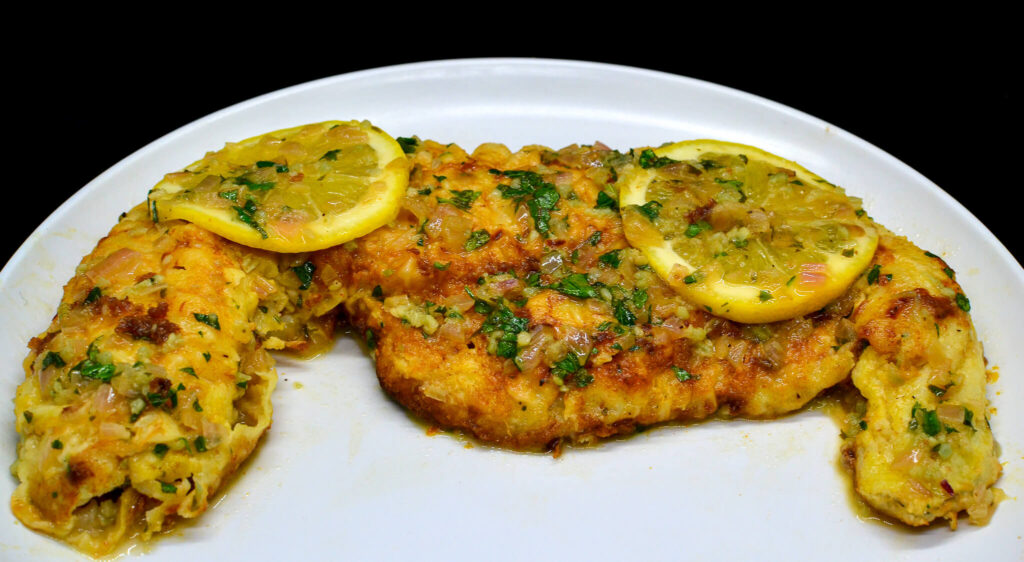
What Is Haddock Francaise?
Haddock Francaise is a classic dish where haddock fillets are lightly coated in flour and dipped in beaten eggs, then pan-fried until golden. The fish is typically served with a lemon-butter sauce made from a reduction of white wine and lemon juice, enriched with butter for creaminess.
Ingredients For Haddock Francaise
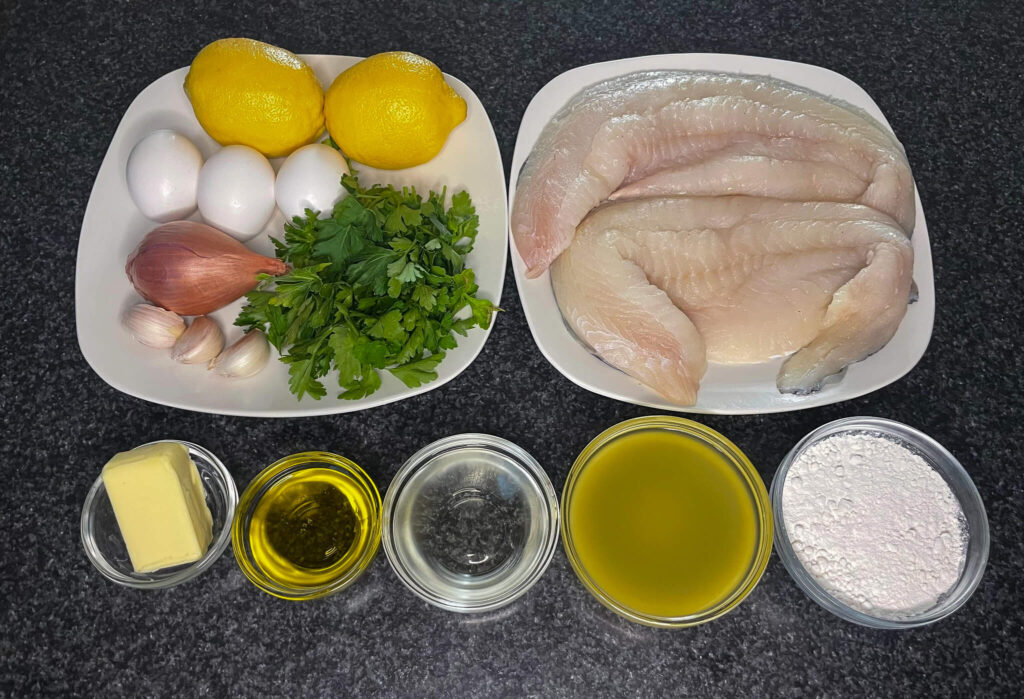

Produce
2 Lemons
1 Shallot
3 Garlic Cloves
Parsley
Refrigerated
3 Eggs
4 Tbsp Butter

Grocery
4 Tbsp Olive Oil
1/2 Cup White Wine
1 Cup Chicken Broth
1 Cup Flour

Meat
2 Haddock Filets

Spices
1 Tsp Salt
1 Tsp Black Pepper
How To Make Haddock Francaise
Step 1
Prep Produce

Before you start cooking, it’s important to prepare your aromatics and garnishes properly. First, peel and finely slice the shallots. This allows them to cook quickly and evenly, blending their sweet, mild flavor into the sauce without dominating it. Next, finely mince the garlic cloves; the smaller the pieces, the stronger the flavor they’ll release into the sauce, adding essential depth to the Francaise sauce.
Wash and pat dry the parsley leaves, then chop them coarsely. Fresh parsley brings a pop of color and a crisp, clean taste that balances the sauce’s richness. It’s more than just a garnish; it’s a key part of the dish’s flavor.
Lastly, wash the lemons and slice them thinly. These slices will garnish the dish, providing a fresh and bright citrus accent that complements the tender, flavorful fish.
Having these ingredients ready and organized before cooking not only makes the process smoother but also boosts the flavors of your Haddock Francaise, ensuring that each element is highlighted beautifully in the final dish.
Step 2
Prep Fish

The star of our dish is the haddock, a fish known for its lean, white flesh and delicate flavor. Begin by selecting fresh haddock filets, ensuring they are of uniform thickness to promote even cooking. Look for filets that are moist and translucent, a sign of freshness. These filets, when cooked properly, offer a buttery texture that melts in your mouth, providing the perfect canvas for our Francaise sauce.
This haddock was purchased at Fresco Fish, who carries some of the highest quality seafood in my area.

To prepare the haddock for cooking, it’s crucial to start with dry filets. Pat them thoroughly with paper towels, absorbing all excess moisture. This step is key to achieving a beautifully browned surface when the fish is seared. Moisture on the fish surface can lead to steaming instead of searing, which would prevent that delightful texture and deepened flavor that browning imparts.

In a bowl, mix eggs with a pinch of salt, some freshly ground black pepper, and a good squeeze of lemon juice. This combination enhances the flavor and serves as the binding agent for the flour coating, helping it stick to the fish. The lemon juice also adds a bright, zesty touch that complements the richness of the dish.

Keep whisking the egg mixture until it becomes frothy and well mixed. This adds air, which helps make the coating light and crispy when cooked, creating a delicate crust on the haddock. Ensure the seasoning is well-balanced to enhance the fish’s natural flavors without overwhelming them.

Begin by placing the front side of the haddock filet on a flat surface. Dredge the filet generously in a shallow dish of flour, covering every part thoroughly. This initial flour coating forms a protective barrier that retains the fish’s natural moisture while cooking, keeping the filet tender and moist. Gently tap the filet to remove any excess flour, ensuring an even crust that will crisp up beautifully and evenly in the pan without clumping.

After flouring the front, turn the filet over to its back side and repeat the dredging process. Ensure the back is also completely and evenly covered with a thin layer of flour. It’s crucial that both sides have an equal amount of flour to prevent uneven cooking or a soggy texture. This consistency in the coating will contribute to a golden, crispy exterior while maintaining the fish’s flaky, moist interior. Applying flour carefully on both sides helps form a visually appealing golden crust, which enhances the flavor and the overall dining experience of your Haddock Francaise.
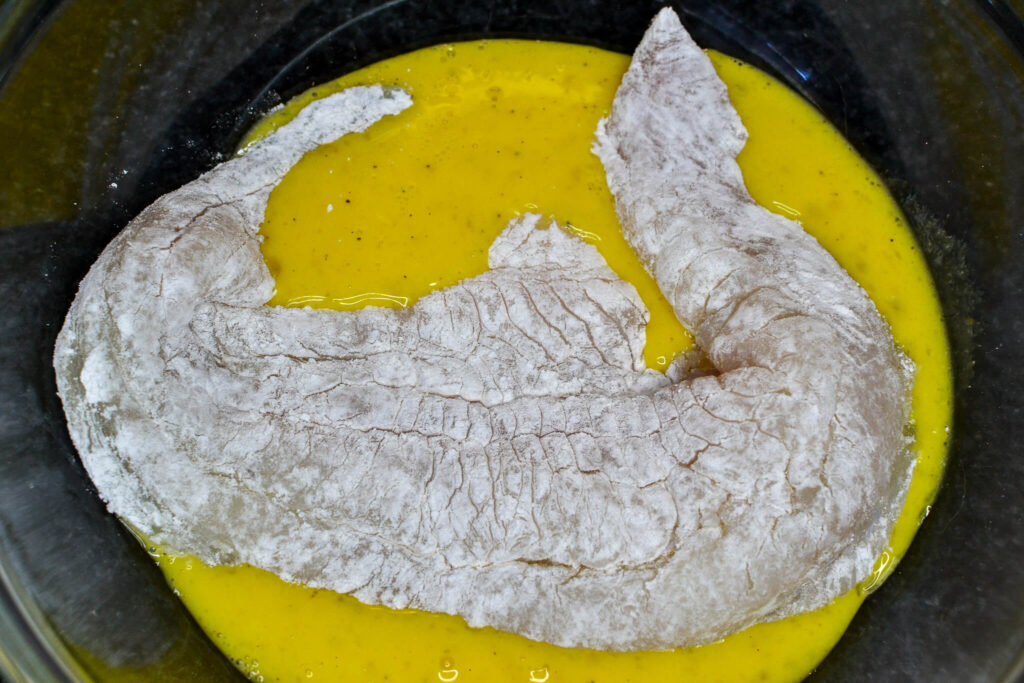
Begin by dipping the back side of the flour-coated haddock filets into the previously prepared egg mixture. Submerge the filet carefully to make sure the egg fully covers the flour-coated surface. This step is crucial because the egg serves as a glue, adhering the flour to the fish and enhancing the filet’s flavor profile. Ensure the back side is completely coated, allowing the egg to reach every crevice and edge. This thorough coating sets the stage for a crispy crust to form during cooking.
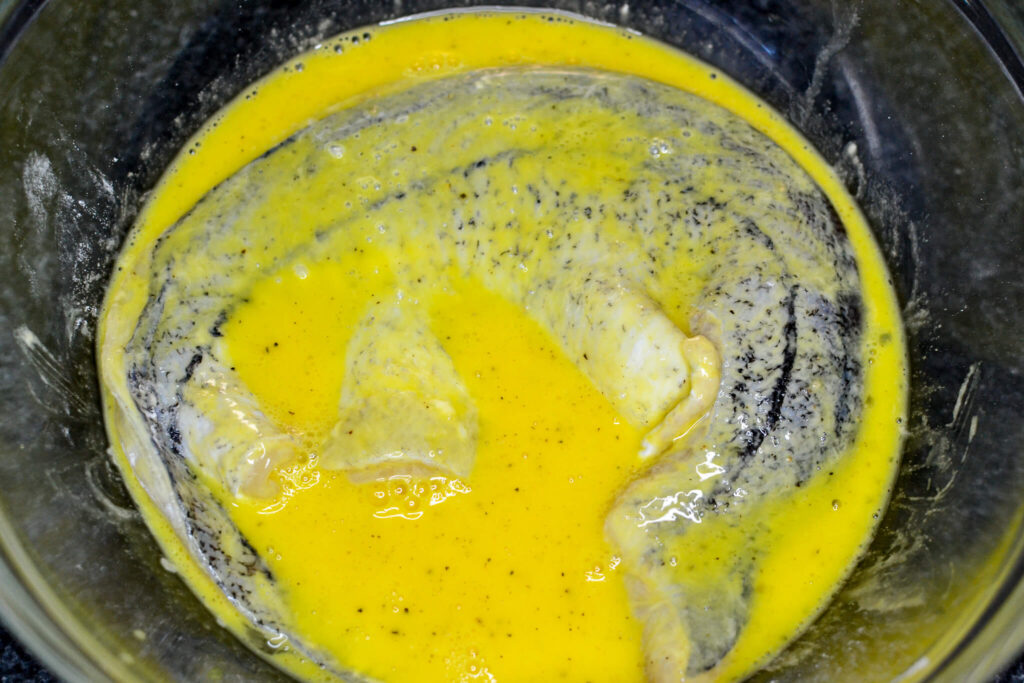
After fully dipping the back, flip the filet to immerse the front side in the egg mixture. It’s important to coat the front as meticulously as the back to ensure evenness in texture and flavor. Make sure the egg mixture covers every part of the front, matching the thorough coating on the back. This uniformity ensures that both sides will cook to a golden and crispy exterior. The egg not only boosts the filet’s flavor but also aids in achieving the golden-brown finish that marks a well-prepared Haddock Francaise.
Step 3
Cook Fish & Make Sauce
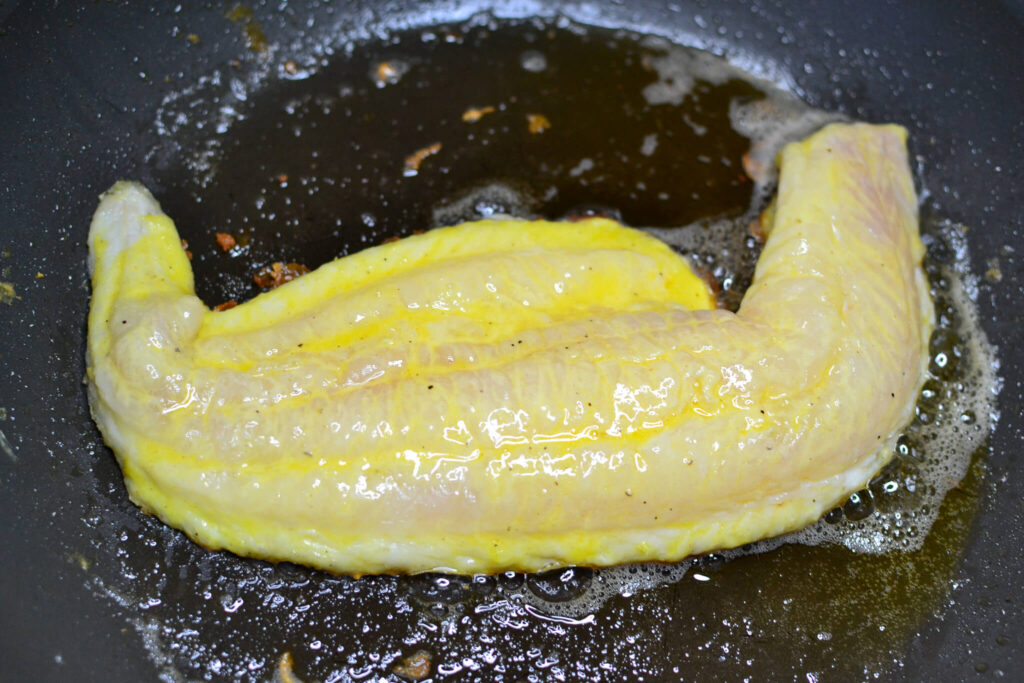
Heat a skillet with a blend of olive oil and a little butter over medium heat. Once hot, add the fish. Cook each side until golden brown, about 3-4 minutes per side. The combination of oils allows for a higher smoking point while adding a buttery flavor.

To prepare the sauce for your Haddock Francaise, start by using the same skillet in which the fish was cooked. With the skillet still hot, add finely chopped shallots. Sauté the shallots over medium heat until they turn translucent and soft. This brings out their natural sweetness, providing a flavorful base for the sauce.

Next, add minced garlic to the pan with the shallots. Stir continuously and cook until the garlic becomes fragrant. This should only take about a minute, as garlic can burn easily and develop a bitter taste if overcooked. The aromatic garlic enhances the complexity of the sauce’s flavor profile.

After the garlic and shallots are sautéed, proceed to deglaze the pan with white wine. Pour in the wine and use a wooden spoon or spatula to scrape up any browned bits left from cooking the fish. These bits are packed with flavor and will enrich the sauce. Allow the wine to simmer and reduce slightly, which concentrates the flavors and burns off the alcohol, leaving only a delicate wine essence.

Finally, add chicken broth to the skillet. Allow the mixture to simmer and reduce slightly, blending all the flavors together. This step combines the various elements into a cohesive, flavorful sauce, preparing the base for reintroducing the fish to finish the dish.
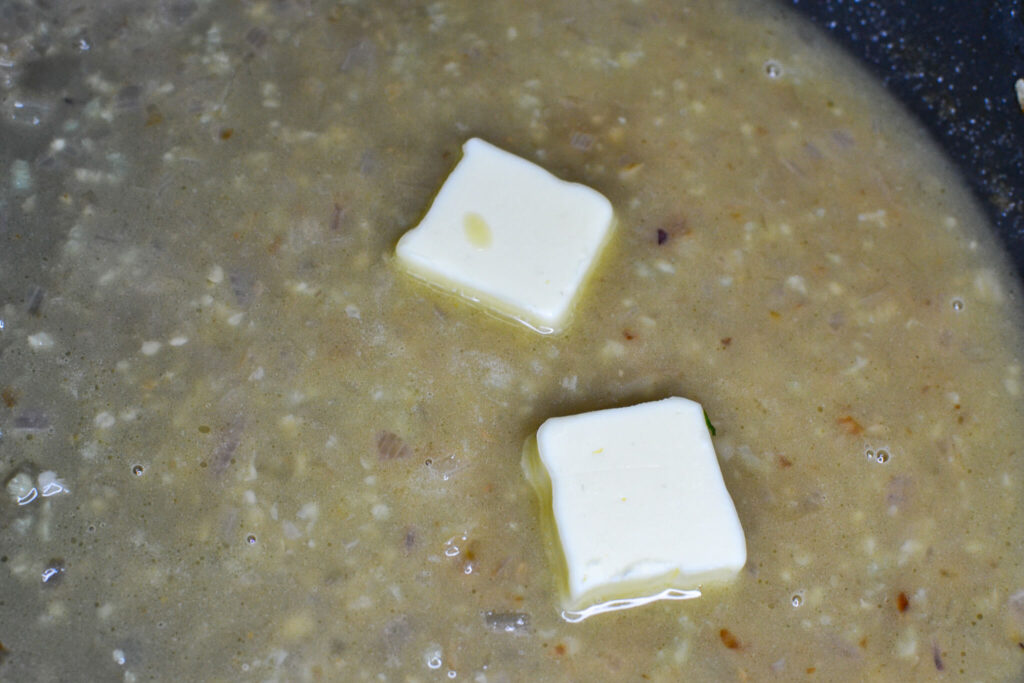
Lower the heat and gradually add cold butter, whisking until the sauce becomes smooth and shiny. Season with salt and pepper to taste. This will thicken the sauce slightly and give it a rich, velvety texture and flavor.
Step 4
Combine
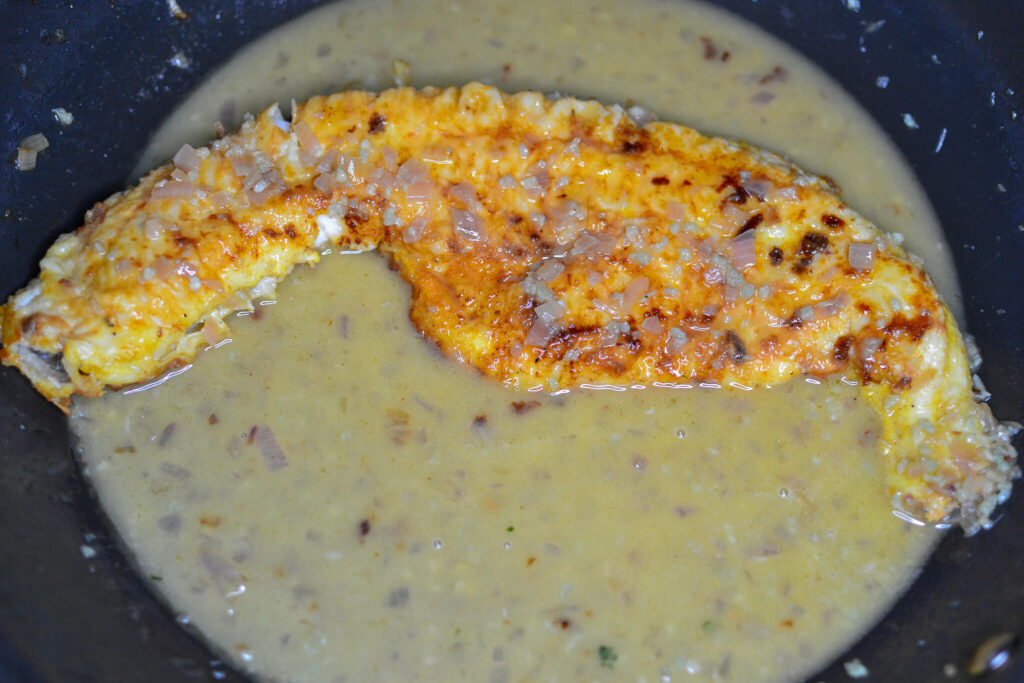
Gently place the cooked fish back into the pan, spooning the sauce over the filets. Allow them to simmer briefly in the sauce to absorb the flavors. This step marries the fish with the sauce, ensuring every bite is infused with its tangy, buttery goodness.

Finally, sprinkle chopped fresh parsley over the dish. The parsley not only adds a touch of color but also imparts a fresh, herbal note that complements the creamy sauce and balances the dish’s richness
Step 5
Enjoy Your Haddock Francaise!

Serve the Haddock Francaise hot, garnished with lemon slices and extra parsley if desired. The final dish should look golden, crispy, and bathed in a luscious lemon-butter sauce, inviting you to taste the harmony of simple yet exquisite flavors. Enhance your culinary creation with a side of steamed vegetables or a light salad for a complete meal. Additionally, pairing this dish with a starch like pasta can beautifully complement the flavors, making for a satisfying and well-rounded dining experience.
Enjoy!

CODA
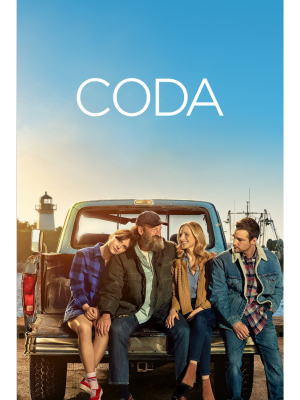
Inspiration
Rossi Family’s Fishing Business
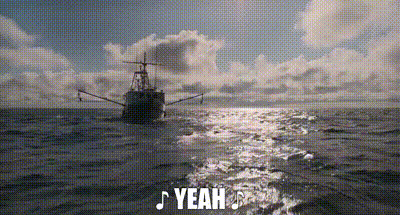
More About Haddock Francaise
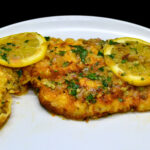
Haddock Francaise
Ingredients
- 2 Lemons
- 1 Shallot
- 3 Garlic Cloves
- Fresh Parsley
- 3 Eggs
- 4 tbsp Butter
- 4 tbsp Olive Oil
- 1/2 cup White Wine
- 1 cup Chicken Broth
- 1 cup Flour
- 2 Haddock Fillets
- 1/2 tsp Salt
- 1/2 tsp Black Pepper
Instructions
Prep Produce
- Peel and finely slice 1 shallot, mince 3 garlic cloves, and wash and coarsely chop fresh parsley.
- Slice 2 lemons thinly for garnish.
Prep Fish
- Pat the haddock fillets dry with paper towels. Season both sides with salt and pepper.
- Dredge each filet in flour, shaking off the excess, then dip into a beaten egg mixture.
Cook Fish & Make Sauce
- In a skillet, heat 4 tbsp of olive oil and 2 tbsp butter over medium heat. Cook the fish for 3-4 minutes per side until golden brown. Set aside.
- In the same skillet, sauté the shallots and garlic until soft. Deglaze with 1/2 cup white wine, scraping up browned bits.
- Add 1 cup chicken broth and reduce. Whisk in 2 tbsp of cold butter until the sauce thickens slightly.
Combine
- Return the fish to the pan, spooning the sauce over the fillets. Let it simmer for a few minutes to absorb the flavors.
- Garnish with fresh parsley and lemon slices.
Enjoy Your Haddock Francaise
- Serve hot with a side of vegetables or pasta, enhancing the dish with the rich lemon-butter sauce for a delightful meal.
Haddock is a popular choice for many seafood dishes, including the classic Haddock Francaise, thanks to its mild and subtle flavor. This white fish is known for its lean, flaky texture, making it great for soaking up the rich, zesty lemon-butter sauce used in this dish.
Unlike stronger-tasting fish like mackerel or sardines, haddock doesn’t overwhelm the delicate flavors of the Francaise sauce. Its mild taste allows the bright lemon and savory buttery notes to shine, enhancing rather than competing with the flavors of the sauce. This makes haddock especially good for those new to seafood or who prefer milder flavors.
The freshness of haddock is crucial in preserving its mild flavor for a Francaise preparation. Ideally, the fish should have a clean, slightly salty smell, not a strong fishy odor. Fresh haddock works well with the Francaise sauce, letting the subtle flavors stand out. Using fresh fish is essential to ensure the flavors blend well with the light and creamy sauce, resulting in a dish that brings out the best in both the fish and the sauce. This combination highlights haddock’s versatility and its appeal to a wide variety of tastes.

